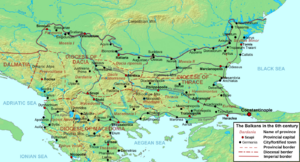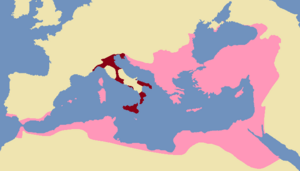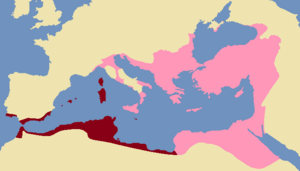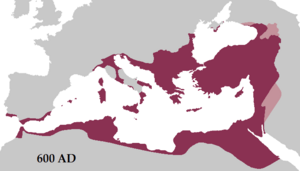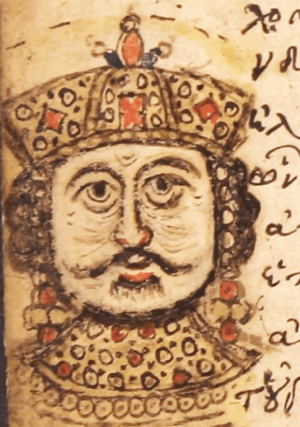Maurice (emperor) facts for kids
Quick facts for kids Maurice |
|||||||||
|---|---|---|---|---|---|---|---|---|---|
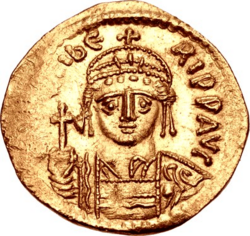
Solidus of Emperor Maurice
|
|||||||||
| Byzantine emperor | |||||||||
| Reign | 13 August 582 – 27 November 602 | ||||||||
| Predecessor | Tiberius II | ||||||||
| Successor | Phocas | ||||||||
| Co-emperor | Theodosius (590–602) | ||||||||
| Born | Mauricius 539 Arabissus, Cappadocia (now Afşin, Kahramanmaraş, Turkey) |
||||||||
| Died | 27 November 602 (aged 63) Constantinople (now Istanbul, Turkey) |
||||||||
| Burial | Saint Mamas Monastery | ||||||||
| Spouse | Constantina | ||||||||
| Issue among others |
|
||||||||
|
|||||||||
| Dynasty | Justinian | ||||||||
| Father | Paul | ||||||||
| Religion | Chalcedonian Christianity | ||||||||
Maurice (born in 539, died in 602) was a Byzantine emperor who ruled from 582 to 602. He was the last emperor from the Justinian dynasty. Maurice was a skilled general before becoming emperor. His predecessor, Tiberius II, chose him as his heir and son-in-law.
Maurice's time as emperor was often filled with wars. He successfully ended a long war with Sasanian Persia and greatly expanded the empire's eastern borders. This meant the Romans no longer had to pay a large yearly tribute to the Persians. He also led many campaigns in the Balkans against the Avars, pushing them back across the Danube River. Maurice was the first Roman emperor in over 200 years to lead campaigns across the Danube.
In the western parts of the empire, he created two large, semi-independent areas called exarchates. These were ruled by exarchs, who were like special governors. He set up the Exarchate of Italy in 584 to stop the advance of the Lombards. In 591, he created the Exarchate of Africa to strengthen the empire's power in the western Mediterranean Sea.
Despite his military and foreign policy successes, Maurice faced money problems. He made some unpopular decisions that upset both the army and the people. In 602, an unhappy officer named Phocas took over the throne. Maurice and his six sons were executed. This event led to a long and devastating war with Persia, which weakened both empires just before the Muslim conquests.
Maurice's reign is well-known thanks to historians like Theophylact Simocatta. The Strategikon, a famous military guide, is often thought to have been written by Maurice or someone close to him. This book influenced military strategies for over a thousand years.
Contents
Life of Emperor Maurice
Early Years and Rise to Power
Maurice was born in 539 in Arabissus, a place in Cappadocia. His father was named Paul. He had a brother, Peter, and two sisters, Theoctista and Gordia. Maurice spoke Greek, unlike some earlier emperors.
He first came to Constantinople, the capital, to work as a secretary for Tiberius. Tiberius was the commander of the imperial bodyguard. When Tiberius became a Caesar (a high-ranking title), Maurice took over his role as commander of the bodyguards.
War with Persia and Becoming Emperor
In 577, even though he didn't have much military experience, Maurice was made the main commander of the Byzantine army in the east. He took over the ongoing war against Sassanid Persia. He also received the high honor of patrikios.
In 578, the war with Persia continued. Maurice led attacks and captured fortresses. The Persian emperor, Khosrow, wanted peace but died before an agreement was made. His son, Hormizd IV, stopped the talks. In 580, the Byzantines and their allies won some battles.
In 582, Maurice won a big victory against the Persians near Constantina. Soon after, Emperor Tiberius became very ill. He chose Maurice to be his successor. Maurice was crowned emperor on August 13, 582. Tiberius died the next day. Maurice became the sole emperor and married Tiberius's daughter, Constantina.
The empire faced many challenges: it was low on money, still at war with Persia, and paying a lot of gold to the Avars. The Slavs were also causing trouble in the Balkan provinces.
Maurice continued the war against the Persians. In 586, his troops defeated them. In 588, a mutiny by unpaid Byzantine soldiers almost gave the Persians an advantage. But the soldiers themselves fought off the Persian attack. Later that year, they won a major victory near Martyropolis. The Byzantine army captured many prisoners and treasures, sending them to Maurice in Constantinople.
In 590, two brothers overthrew the Persian King Hormizd IV and made his son, Khosrow II, the new king. However, a general named Bahram Chobin rebelled and defeated Khosrow. Khosrow and the two brothers fled to the Byzantine court. Maurice decided to help Khosrow get his throne back, even though his advisors disagreed. In 591, the combined Byzantine-Persian army defeated Bahram Chobin. This victory was very important. Maurice finally ended the war successfully by helping Khosrow become king again.
Khosrow became like an adopted son to Maurice to strengthen their alliance. Khosrow rewarded Maurice by giving the empire western Armenia, including important cities. This peace treaty saved the Byzantine Empire millions of gold coins each year.
Campaigns in the Balkans
The Avars arrived in the Carpathian Basin in 568. They attacked the Byzantine defenses but were pushed back. For a while, the Byzantines paid them a large amount of gold each year. In 579, Emperor Tiberius stopped these payments because his treasury was empty.
The Avars responded by attacking Sirmium, an important city, which fell around 581. They then demanded even more gold. When refused, they used Sirmium to launch attacks on poorly defended forts along the Danube River. They began to raid the northern and eastern Balkans. The Slavs also started settling in the area from the 580s.
In 584, the Slavs threatened Constantinople, the capital. In 586, the Avars attacked Thessalonica, while the Slavs reached as far as the Peloponnese. After his victory against Persia in 591, Maurice could finally focus on the Balkans. He launched several campaigns against the Slavs and Avars.
His army retook Singidunum (modern Belgrade) in 592. His commander, Priscus, defeated the Slavs, Avars, and Gepids in 593. Priscus even crossed the Danube into what is now Wallachia to continue his victories. Maurice's brother, Peter, also won a victory in Wallachia. Priscus defeated the Avars again in 595.
By 602, the Byzantine troops were able to control the Danube River line again. Maurice also planned to bring Armenian settlers to rebuild the areas in the Balkans that had been destroyed. He wanted to continue fighting the Avars to either destroy them or force them to surrender.
Changes at Home
In the west, Maurice reorganized the Byzantine lands in Italy into the Exarchate of Italy. This new system combined civil and military power under one leader, the exarch. This helped slow down the advance of the Lombards in Italy. In 591, he created a similar second Exarchate in Byzantine North Africa.
In 597, Maurice wrote his will, explaining his ideas for governing the empire. He wanted his eldest son, Theodosius, to rule the eastern provinces from Constantinople. His second son, Tiberius, would rule the western exarchates from Rome. Some historians believe he planned for his younger sons to rule from other major cities. His goal was to keep the empire united. However, Maurice's death stopped these plans from happening.
Maurice was generally accepting of different Christian beliefs, though he supported the Council of Chalcedon. He had some disagreements with Pope Gregory I about the defense of Rome against the Lombards.
Maurice's efforts to strengthen the empire slowly succeeded, especially after the peace with Persia. However, his popularity declined, mostly because of his money policies. In 588, he cut military wages, which led to a serious mutiny by soldiers. He also refused to pay a small ransom in 599 or 600 to free 12,000 Byzantine soldiers captured by the Avars. The prisoners were killed. A group of protesting soldiers, led by an officer named Phocas, was turned away in Constantinople.
Family Life
Maurice and his wife, Empress Constantina, had nine known children:
- Theodosius (born 583 or 585, died after 602). He was the first heir born to a ruling emperor in a long time. He became a Caesar in 587 and co-emperor in 590.
- Tiberius (died 602)
- Petrus (died 602)
- Paulus (died 602)
- Justin (died 602)
- Justinian (died 602)
- Anastasia (died around 605)
- Theoctista (died around 605)
- Cleopatra (died around 605)
Some eastern sources mention a daughter named Miriam/Maria who married Khosrow II, but Byzantine sources do not confirm this.
Maurice's brother, Petrus, was also killed at the same time as Maurice.
Death of Emperor Maurice
In 602, Maurice, still facing money problems, ordered his army to stay for winter beyond the Danube River. The tired soldiers rebelled against the emperor. Maurice seemed to misunderstand the situation and kept ordering his troops to attack instead of returning to their winter camps. The soldiers felt Maurice no longer understood their needs and declared Phocas their new leader. They demanded that Maurice step down and name his son Theodosius or General Germanus as his successor.
Riots broke out in Constantinople. Maurice took his family and left the city on a warship heading to Nicomedia. His son Theodosius was sent to seek help from the Persians, but he never reached them. Phocas entered Constantinople in November and was crowned emperor. Phocas's troops captured Maurice and his remaining family. They were brought to the Harbor of Eutropius at Chalcedon.
Maurice was killed at the harbor on November 27, 602. He was forced to watch his five younger sons executed before he himself was beheaded.
Empress Constantina and her three daughters were initially spared and sent to a monastery. They tried to escape but were caught and sent back to the monastery by Phocas. A few years later, they were also executed at the same harbor after being accused of plotting against Phocas. Maurice's entire family was buried at a monastery founded by his sister Gordia. The Persian king Khosrow II used Maurice's overthrow and murder as a reason to start a new war against the empire.
Legacy of Maurice
His Impact as Emperor
Maurice is remembered as a capable emperor and military leader. He was known for his good judgment, dedication to the public, and bravery. He showed his skills in military and foreign affairs during his campaigns against the Persians, Avars, and Slavs. His administrative changes were far-sighted. They lasted for centuries and helped create the later system of military districts called themes.
His court, army, and government used Greek. He also supported science and the arts. Maurice is traditionally believed to be the author of the military book Strategikon. This book is praised in military circles as a very advanced theory of combining different types of forces until World War II. However, some historians now think his brother or another general wrote it.
Maurice's biggest weakness was not understanding how unpopular his decisions were. Historian C. W. Previté-Orton noted that Maurice had "too much faith in his own excellent judgment without regard to the disagreement and unpopularity which he provoked."
This flaw cost him his throne and his life. His death was a turning point. The war with Persia that followed weakened both empires. This allowed the Slavs to settle permanently in the Balkans and prepared the way for the Arab-Muslim expansion. Historian A. H. M. Jones believes Maurice's death marked the end of the era of Classical Antiquity. The chaos that followed changed society and politics forever.
Stories and Legends
|
||||||||||||||
The first legendary stories about Maurice's life appeared in the ninth century. According to the historian Theophanes the Confessor, the death of the imperial family was due to a divine choice. Christ supposedly asked the emperor to choose between a long reign or death and a place in heaven. Maurice chose the second option.
A similar story is found in a short Syriac text about the emperor's life. It says Maurice prayed to receive punishment in this world and a "perfect reward" in heaven. An angel offered him this choice. Maurice was later made a saint by the Eastern Orthodox Church.
Another legend in the same text says Maurice stopped a nurse from secretly swapping one of his sons with another child. This would have saved at least one of his heirs, but Maurice refused.
See also
 In Spanish: Mauricio (emperador) para niños
In Spanish: Mauricio (emperador) para niños



